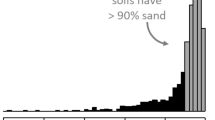Abstract
Changing land use from forested environments to agricultural and/or urban spaces dramatically alters soil chemical, physical, and biological properties and thereby influences the survivability of landscape plants installed in these areas. This site analysis was conducted along New Hope Road, in Pickens County, SC, to develop a sustainable landscape design for the greenway corridor to buffer future cuttings of pines and offer a variety of recreational and educational opportunities for the community. Using a “design with nature” framework, an interdisciplinary team collaborated on a thorough observation and analysis of the inherent qualities of the site, historical documents and aerial photographs to describe the land use history of the site. The dominant soil series found on the site were Cecil clay loam, Cecil sandy loam, and Pacolet clay loam. Surface soil chemistry tests were conducted to examine soil and buffer pH; organic carbon and nitrogen contents; nitrate–nitrogen; extractable phosphorus, potassium, calcium, magnesium, zinc, manganese, copper, boron, and sodium; lime requirements and recommendations; cation exchange capacity; acidity; and percent base saturation. Analysis of site history, aerial photographs, and soil testing revealed that a history of intensive agricultural land use and managed forestry on the site has noticeably altered the soil quality. Severe soil erosion and compaction brought about by a combination of anthropogenic and natural causes have left much of the site with infertile soils lacking a true topsoil layer and characterized by low pH. These qualities present numerous challenges when attempting to modify and install vegetation. Based on historical land use, soil analysis, and plant species characteristics, a final landscape design was created that addressed the environmental opportunities, constraints of the site and provided site- and plant-specific fertilizer recommendations for successful establishment and maintenance of this greenway corridor.





Similar content being viewed by others
References
Adams G (1994) Birdscaping your garden. Rodale Press, Pennsylvania, p 208
Burns R, Honkala B (1990) Silvics of North America volume 2: hardwoods. Agric. Handb. 654. U.S. Department of Agriculture, Forest Service, Washington, DC, pp 490–496
Campbell WF, Varga WA (1993) Turfgrass and Ornamental Plants. In: James DW, Topper KF (eds) Utah Fertilizer Guide. Utah State University Extension, Utah
Cogliastro A, Gagnon D, Bouchard A (1997) Experimental determination of soil characteristics optimal for the growth of ten hardwoods planted on abandoned farmland. For Ecol Manage 96:49–63
Craul PJ (1992) Urban soil in landscape design. Wiley, New York, p 396
Dahnke WC (1971) Use of the nitrate specific ion electrode in soil testing. Commun Soil Sci Plant Anal 2:73–84
Darke R (1999) The color encyclopedia of ornamental grasses. Timber, Portland, OR, p 326
ESRI (2004) ArcGIS 9.1, Redlands, CA
Jim CY (1998) Urban soil characteristics and limitations for landscape planting in Hong Kong. Landsc Urban Plan 40:235–249
Jones JB Jr (2001) Laboratory guide for conducting soil tests and plant analysis. CRC, London, p 363
McHarg IL (1992) Design with nature. Wiley, New York, p 208
Minnesota Department of Natural Resources (2005) DNR Garmin Extension for ArcView. Web: http://www.dnr.state.mn.us/mis/gis/tools/arcview/extensions/DNRGarmin/DNRGarmin.html
Moore K, Franklin R (2002) EC 476 Nutrient management for South Carolina based on soil-test results. Clemson University Extension Service, Clemson, SC, p 80
Pickett STA, Cadenasso ML, Grove JM, Nilon CH, Pouyat RV, Zipperer WC, Costanza R (2001) Urban ecological systems: linking terrestrial ecological, physical, and socioeconomic components of metropolitan areas. Ann Rev Ecolog Syst 32:127–157
Porcher RD, Rayner DA (2001) A Guide to the wildflowers of South Carolina. University of South Carolina Press, Columbia, SC, p 551
Richter DD Jr, Markewitz D (2001) Understanding soil change: soil sustainability over millennia, centuries, and decades. Cambridge University Press, New York, p 272
Soil Survey Staff, Natural Resources Conservation Service (2006) United States Department of Agriculture. Official Soil Series Descriptions. Web: http://www.soils.usda.gov/technical/classification/osd/index.html
USDA, NRCS (2005) The PLANTS Database, Version 3.5 (http://www.plants.usda.gov). Data compiled from various sources by Mark W. Skinner. National Plant Data Center, Baton Rouge, LA 70874-4490 USA
Acknowledgements
The authors gratefully acknowledge the funding provided by Stassen Thompson and Clemson University Land Management, operational support by Clemson Experimental Forest Staff, soil analysis conducted by the Clemson University Agricultural Services Soil Testing Laboratory, landscape design drawings by Ole Russell Sleipness, field assistance by Dr. Peter Kapeluck and Wayne Carroll, site grading provided by Pickens County, and the City of Clemson for soil amendments, planting assistance, educational demonstration and mulch donations. Additional support was provided by the U.S. Department of Agriculture (SC-1700278) and the Natural Resources Conservation Service of the U.S. Department of Agriculture (NRCS-69-4639-1-0010) through the Changing Land Use and Environment (CLUE) Project at Clemson University. Any opinions, findings, conclusions or recommendations expressed in this publication are solely those of the authors and do not necessarily reflect the views of the USDA/NRCS. This is a Technical Contribution no. 5168 of the Clemson University Experiment Station.
Author information
Authors and Affiliations
Corresponding author
Rights and permissions
About this article
Cite this article
Keydoszius, J.R., Cox, S.K., Haque, M.B. et al. Historical land use and soil analysis guiding corridor landscape design. Urban Ecosyst 10, 53–72 (2007). https://doi.org/10.1007/s11252-006-0010-7
Received:
Accepted:
Published:
Issue Date:
DOI: https://doi.org/10.1007/s11252-006-0010-7




